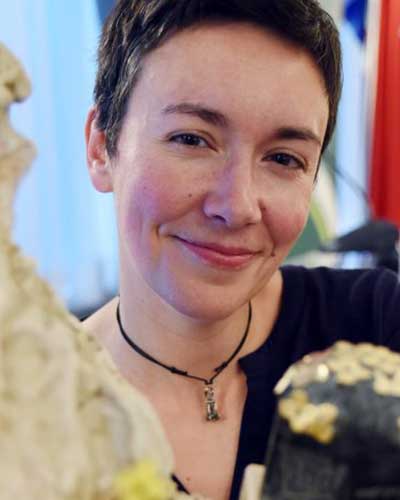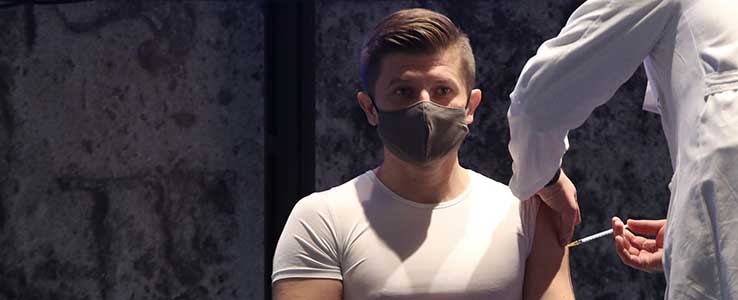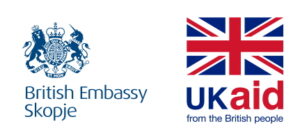Vedrana Simičević
 Favoritism, weak strategy and poor communication with the public were the features of the first months of vaccination and they are the reasons that Croatia is currently at the bottom of the EU scale in terms of percentage of vaccinated population. As the third wave of the pandemic rages, the citizens are frustrated to see healthy middle-aged people already vaccinated in some cities, while elsewhere those over 70 are still waiting for a call.
Favoritism, weak strategy and poor communication with the public were the features of the first months of vaccination and they are the reasons that Croatia is currently at the bottom of the EU scale in terms of percentage of vaccinated population. As the third wave of the pandemic rages, the citizens are frustrated to see healthy middle-aged people already vaccinated in some cities, while elsewhere those over 70 are still waiting for a call.
When the first delivery of the vaccine against COVID-19 finally arrived in Croatia in the early morning hours of 26 December 2020, the scene was a bit anticlimactic – the director of the Croatian Institute of Public Health (HZJZ) Krunoslav Capak solemnly welcomed a small cardboard box that was big enough to house a modest 9,750 doses of Pfizer/ BioNTech Comirnaty vaccine. Still, many saw in it the first serious hope that the beginning of the end of a pandemic nightmare called SARS-CoV-2 was finally here.
Three and a half months later, the number of newly infected people in Croatia is rapidly growing again, almost two thousand patients with COVID-19 were hospitalized, 170 of which are on a respirator, and up to 30 people a day are dying on regular basis due to the severe forms of this disease. The third wave, it seems, is in full swing. Three months after that first very promising early morning delivery, Croatia, according to the European Center for Disease Monitoring and Control, vaccinated 12.6 percent of the population with one dose up to Thursday, 8 April, and only 2.9 percent have been vaccinated with two doses. Statistics also say that 710,970 doses have arrived in Croatia so far, and 525,328 have been used. The speed at which vaccination takes place, roughly equals to the speed of Croatian trains compared to world standards, and this suggests that the pandemic nightmare is far from the end.
Near the bottom in EU in terms of vaccination rate
As an example, by 23 March, people over the age of 60, that is, people who belong to the risk age group, received 280,186 doses in the current second phase of vaccination. To put this figure in context, we should say that in Croatia, according to the Government's vaccination plan published in December, there are more than 760,000 people over the age of 65 who were not included in the first phase – the one in which people in homes for elderly and decrepit persons were vaccinated. Moreover, over half a million Croats, according to the data, are over 70 years old. Therefore, we can roughly conclude that the second phase of vaccination with the beginning of spring and the third wave of the pandemic had not yet been implemented 'half way through'. The vaccination has accelerated somewhat over the last two weeks, but the second phase still seems to be far from over.
If you ask the Croatian Institute of Public Health, they will answer, as they did for the purposes of this text, that the reasons for such a slow vaccination are "significantly less delivery of vaccines than promised" because "all manufacturers failed with the quantities they supply". This is, as is well known, painful truth – the pharmaceutical companies, especially AstraZeneca, whose vaccines Croatia ordered the most, are drastically late with deliveries to the European Union. And Croatia, like all other member states, except Hungary, has agreed to the EU negotiating orders on its behalf, implying an equal distribution of vaccines. But this does not fully explain why most other EU countries - more precisely all but Latvia, Bulgaria and Finland, have a higher average vaccinated population.
For example, neighboring Slovenia vaccinated with two doses 6.9 percent of the population, and most other EU countries also have at least twice the percentage of the population fully vaccinated compared to Croatia. In the Union, the highest vaccination rates are in Malta (12.7%) and Hungary, which was the only one to order the vaccine independently of the EU (11.3%), but also countries such as Spain, Portugal or Greece have vaccinated more than 7% of the population with two doses.
Such a balance of power was most likely due to last year's decision of the Croatian Government to order most of the doses from AstraZeneca. This vaccine was given a preference because, as stated by the CNIPH, "AstraZeneca was the first to start negotiating and contracting with the European Commission and during the summer of 2020 was the most promising candidate for approval for use in the EU." But throughout the year, Moderna and BioNtech/ Pfizer led the vaccine race, starting with the first phase of clinical trials in March and April, respectively. In late August, when AstraZeneca briefly halted the trials, it was clear to many that mRNA vaccines would likely be the first to hit the market.
Whether the only factor that resulted in Croatia receiving fewer vaccines so far than most other member states, depending on the population, was that most of the doses ordered from AstraZeneca, which is the company that is mostly late in delivering the promised quantities, is hard to say. But it points to a poor "game review" when making long-term decisions about vaccination strategies. It was not until the beginning of April that Prime Minister Andrej Plenković announced that, in accordance with the European Council's decision on the proper distribution, Croatia would receive an additional 747,000 doses of the Pfizer vaccine, which would compensate for the late delivery of AstraZeneca.
A parade of pandemic favoritism
But even when the pessimistic vaccination statistics are attributed to the potentially weaker political influence of small Croatia in the complex dynamics of the supposedly equal distribution of vaccines within the EU, it is difficult to say that Croatia is coping well with the public health task of vaccination.
Let's remind ourselves that it has recently been a year since Croatia, like many other countries, entered the first lockdown. It quickly became clear that we would not get rid of the pandemic so quickly. It also became clear relatively quickly that the first vaccines would be available in early 2021. In that regard, the current Government of the Republic of Croatia had eight months to prepare one of the most important tasks in its mandate – the strategy for effective vaccination against the biggest public health plague since the beginning of the new millennium. For a country whose public health rests on the foundations of genius Andrija Štampar (1888-1958) this task was to be almost routine. But despite more than enough time to prepare, the first three pandemic months of this year were marked by clumsy vaccination, frequent "queue-jumping" vaccinations and poor communication of vaccination information to the public.
The first phase of vaccination of health workers and people in elderly homes is not over yet, and the media have already begun to uncover incredibly shameful examples of 'queue-jumping' vaccinations of various politicians, powerful people, and even public officials. While the Canadians appalled over the example of a rich man who cheated in order to get himself and his wife vaccinated and which ended in criminal charges and public humiliation, a real spectacle of pandemic nepotism took place with impunity in Croatia, of which only bizarre excuses were more sameful.
 Source: lider.media
Source: lider.media
The media first revealed that at the end of January, the rector of the University of Zagreb, Damir Boras, who, by the way, had already recovered from COVID-19, was vaccinated. The explanation was that the rector accidentally stopped by his wife's dental office at the very moment when the staff was being vaccinated, and just be chance it happened that two doses remained unused so they were complimentary given to the Boras couple, explained the head of the dental clinic for dnevnik.hr, "so the vaccines are not thrown away". He admitted, however, that the rector was initially "inquiring into the possibility of vaccination in their office.
Now, the legendary "not to be discarded" phrase has become the mantra for other cases of public officials and people in power who were discovered by the media that they were vaccinated via 'queue-jumping', such as the head of the Croatian Chamber of Commerce Luka Burilović and vice president of the Croatian Handball Federation Zoran Gobac. The director of the Clinic for Infectious Diseases "Dr. Fran Mihaljević" and a member of the Crisis Staff Alemka Markotić admitted that she vaccinated her mother at the clinic. The director of the Dubrovnik hospital, Marijo Bekić, vaccinated members of his family. Former Deputy Prime Minister Slavko Linić was also vaccinated via 'queue-jumping'.
None of the publicly named violators of vaccination regulations bore any responsibility. It is therefore not surprising that many Croats today know examples of people who were vaccinated during the winter even though they are not in the risk groups. Admittedly, in a country where almost every fifth resident "needs to call favors and connections" in the health care institutions, and "call someome" is almost a normal modus operandi that often literally saves lives, no one is particularly surprised by this pandemic nepotism.
Poor vaccine distribution strategies
A far bigger source of frustration for citizens, but also for family doctors, is the poor strategy of distribution of vaccine doses to outpatient clinics. The Government vaccination plan from December 2020 states, among other things, that "each county Office will receive a quantity proportional to the size of the population it covers, and shall distribute the vaccine to doctors who do the vaccination in the area." Such a strategy has resulted in the practice where the medical practitioners were receiving the vaccine quantities regardless of the number of risk group users, although this number varies greatly from case to case.
One consequence is that many physicians are indeed forced to call their users from non-risk groups for use of the vaccines so they do not expire, while others are not yet even close to vaccinating their populations exposed at risk. In other words, it happens that even members of the same family who are in their forties but are not in the risk group receive a call for vaccination before their parents. The differences are even greater when comparing individual counties and cities, so somewhere healthy middle-aged citizens are already being vaccinated, while elsewhere many who are eighty years old are still waiting for a call.
"Each office differs in population structure. This statistics is there but obviously no one has looked at it", says Leonardo Bressan, President of the Coordination of Croatian Family Medicine for the Primorje-Gorski Kotar County, adding that family doctors spend a huge amount of time informing users about vaccinations. The CNIPH also acknowledges that one of the reasons for the vaccination disbalance in cities and areas is "the unequal number of elderly people, health workers and people with chronic diseases in relation to the number of inhabitants."
Is it logical, then, to ask why this statistical factor that is easy to verify was not implemented timely in the strategy? It seems that this issue is becoming deeper as the vaccination progresses and the disparities between individual areas become larger and more apparent, since the social media is full of posts by young people who were vaccinated and elderly people asking how to get vaccinated.
The confusing application system
From the position of a citizen waiting to be vaccinated, the whole system seems confusing - should you register with your family doctor or sign up in the national system via a website that only came to life in early March? Many of those who opted for the latter on the same day when that opportunity opened up were met with an unpleasant surprise at the end of March – it was only 27 days later when the official confirmation arrived that they were registered in the system. There was no word on any other details about the future date and method of vaccination in these generic emails, which were apparently sent to thousands of emails on the same day. Furthermore, the official instructions say that all people who apply for vaccination will be entered in a single list, but our interlocutor, Leonardo Bressan, claims that family doctors do not have insight into the system of people who signed up through the internet platform.
Given that the vaccination strategy is clearly changing "on the fly" and that, according to the Croatian Trade Union of Tourism and Services, the tourism workers have recently been included in the priority groups, the average Croat under the age of 65 with no serious diagnoses and with no connections in the health system, rightfully assumes that he/ she will be vaccinated approximately on the same date as waiting for MRI or CT scan – which is one year after registration. More and more citizens these days are thinking about visiting neighboring Serbia, reading about the surplus of vaccines that is generously shared with foreigners.
Meanwhile, with new lockdowns happening in Europe and as the announcements for the so-called Covid passport intensify around the world, a question to which there is currently no good answer surfaces: will the residents of countries with poorer vaccinations become discriminated against people at the borders?
Communication failure
This brings us to another big problem that has accompanied the Croatian fight against the pandemic from the very beginning. Communication of messages to the public by the competent institutions is extremely poor. Instead of an aggressive media campaign in which the citizens would be constantly "bombarded" from TV programs, the Internet, social media and other advertising platforms with videos and graphics that explain in simple terms what the virus is, what they are and why preventive measures are needed, what the symptoms of the disease look like, what is the risk for certain groups of citizens, the entire communication was reduced to the HZJZ website and the famous koronavirus.hr website. Instead of commenting on certain scientific aspects of the pandemic in a focused and professional manner, the members of the Crisis Staff spent too much time on public speeches with which they unconvincingly tried to defend the contradictory decisions.
It is amazing, in fact, that someone in the 21st century, in an era of social media that multiply the spread of fake news and misinformation, expects that, in order to educate and raise the public awareness - which is the first prerequisite for compliance - it is simply enough to focus on a few websites. Add to that some extremely politically colored Crisis Staff decisions, and it is not surprising that the public confidence has been seriously shaken over the past summer with regards to many of the activities.
Information cacophony
In the absence of clear messages and education from the relevant institutions, the main word on this issue was lead by the media, some of which did the lion's share of the work, but often media space was given to literally anyone who wanted to say anything about the pandemic. The result was a kind of informative cacophony, and this Government communication modus operandi continued during the vaccination period.
Now that, for example, a large number of citizens, scared by the information about very rare but serious side effects, refuse to be vaccinated with AstraZeneca, government experts still think it is enough to repeat several times "on the air" that the vaccines are safe and threaten that the one who refuses to be vaccinated needs to go back to end of the line again. Moreover, if we sum up all these problems, the recent announcement by Mr. Plenković that Croatia will vaccinate 50 percent of the population by the end of June, currently seems like pure science fiction.
This blog is published as part of the regional blogging initiative “Tales from the Region”, led by Res Publica and the Institute of Communication Studies, in partnership with Macropolis (Greece), Lupiga (Croatia), Sbunker (Kosovo), Ne Davimo Beograd (Serbia), Analiziraj (Bosnia and Herzegovina), and Pcnen (Montenegro).
Please refer to the Terms before commenting and republishing the content.
Note: The views and opinions expressed in this article are those of the author and do not necessarily reflect the views of the Institute of Communication Studies or the donor.


